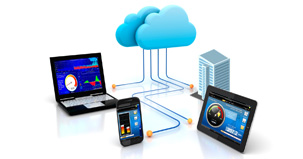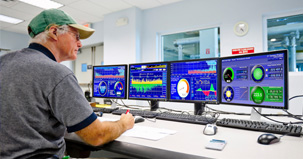- Home
- Smart Data
Smart Data
Actionable intelligence on energy and water use:
- Helps users identify inefficencies, and waste
- Provides real-time feedback on conservation
Right data for the right audience:
- Facility managers identify when and where energy is wasted
- CFO's can track and verify financial savings from initiatives
- Company knows its carbon and water footprint
Related Products
 Information any time, anywhere
Information any time, anywhere - Smart User
Smart User
Smart users leverage real-time data and reduce energy and water use by:
- Continuously identifying opportunities
- Acting on opportunities
- Tracking and verifying savings
- Sustaining savings
Related Products
 Monitor, Manage, Maintain
Monitor, Manage, Maintain - Smart Community
Smart Community
A smart community is one where all stakeholders are engaged in energy and water conservation. A smart community can be achieved by:
- Showing people precisely how much they are using
- Providing real-time feedback on conservation actions
- Effectively communicating efficiency results
Related Products
 Communicate and Conserve
Communicate and Conserve - Smart Grid
Smart Grid
Smart grid, as we define it, is a "green grid", with efficient resource use and the key to a low-carbon future. We help our customers prepare for the smart grid by:
- Engaging users with smart data
- Enabling smart users to increase resource efficiency
- Educating & empowering smart communities
Related Products
 Smart grid and a smarter future
Smart grid and a smarter future - Smart Buildings
Smart Buildings
Smart buildings maximize resource (energy, water, capital) efficiency. These buildings are optimized using energy and water management process with high data visibility which lead to reduced energy and water spending.
- Higher operating income and higher asset values for owners
- Increased productivity for occupants
- Lower carbon footprint for the community
 Resource efficient buildings
Resource efficient buildings
Subtitle!
Recent Posts
When it Comes to Sustainability and Transportation, Travel Behavior Modification is Sorely Needed
Transportation, according to the World Energy Council, accounts for up to 25 percent of the global energy consumption and carbon dioxide emissions.
What, precisely, does that mean? And, does it really matter when it comes to green? Make no mistake about it, environmental experts maintain, one can hardly have a conversation about energy consumption without including the transportation sector.
However, since the private sector and government have yet to decide on a universal definition for the category, we are also without a set of standards for measuring the impact worldwide transportation usage has on the environment. With any luck, someday, guidelines governing the impact transportation has on the environment may resemble the LEED standards that govern green buildings. Until then, we must find other ways to focus on getting around in the greenest way we can. One way is being called “travel behavior” -- the how, why and what of the decisions people make.
- How people get from Point A to Point B. They might walk, bicycle, drive alone, car share, take a bus or the train, and fly.
- Why people travel which ranges from buying food for dinner to commuting to the office to going on vacation on the other side of the world.
- What are the environmental, social, and economic costs, or the “triple bottom line?” For example, every car trip must take into consideration the cost of pollution, the effects air pollution has on human health, and, because of increased dependency on oil imports, can impact the price of gasoline, decreasing consumer purchasing power.
It’s clear that as a global society we must focus on travel behavior because that is one area that every single effort can provide immense change. For example, the simple act of carpooling and reducing one-person car trips can impact the triple-threat costs. For that matter, opting for a bike ride instead of a local car ride – be it to the food store or even the office – can reduce fuel costs and environmental impact. (And, the health benefits will add up, too!)
Or, consider other kinds of green transportation that may even offer financial incentives, such as tax credits for electric cars. The U.S. government provides a $7,500 one for the Nissan Leaf.
Don’t count the private sector out! Changes here may not come in the form of tax breaks but having to pay less for things might draw some consumer interest. For example, companies can lower prices if they spend less on the daily cost of doing business such as holding webinars instead of airline travel to meetings.
Sure, we as a society are set in our ways. We enjoy being able to choose from multiple places to stop for a morning cup of coffee on our way to work and we will forever marvel at the mysteries of air flight. While change isn’t easy, it’s inevitable. And, though it’s a long road ahead, we all must put one foot in the other and start the trek – literally.